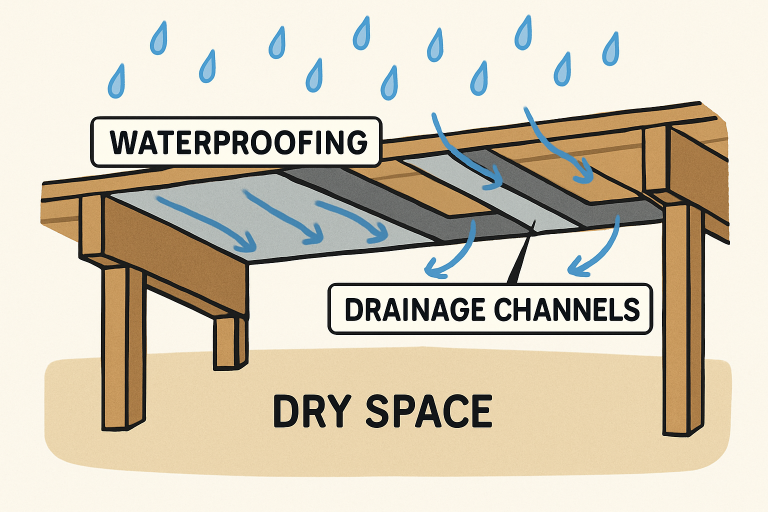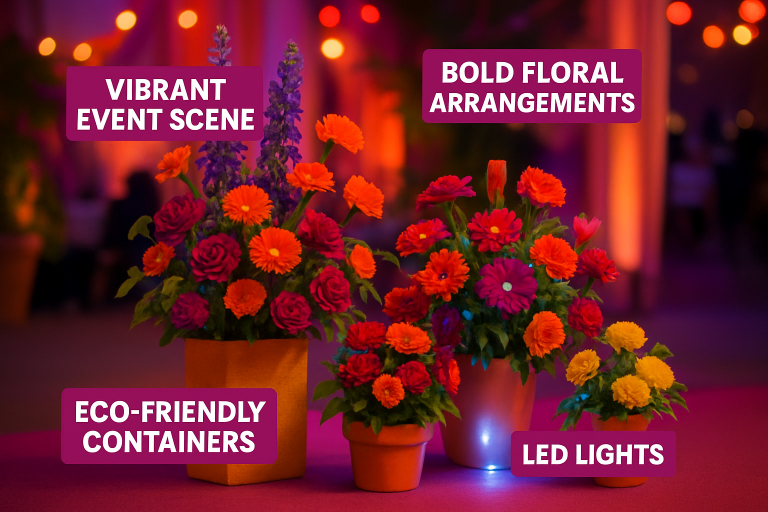Life Style
Comprehensive Guide to Under-Deck Solutions for a Stylish and Organized Space
Published
4 months agoon
By
Ninja
Introduction
Many homeowners overlook the potential of the space beneath their deck, but transforming this area can significantly elevate their outdoor living environment. Whether you seek additional storage, a new lounging area, or a functional extension of your home, investing in under-deck solutions opens up new possibilities for maximizing your yard’s utility and enhancing its curb appeal. Imaginative design and proven waterproofing methods help this often-unused space become a true backyard asset.
Under-deck spaces can offer both style and functionality with the right approach, creating an area that accentuates your existing landscape and adds value to your home. With a careful evaluation of your current setup and thoughtful selection of features, you can easily convert what was once wasted space into a vibrant outdoor retreat or effective storage solution.
Assessing Your Under-Deck Space
Before initiating any renovation or enhancement, carefully assess the under-deck area you have available. Consider practical aspects such as the height between deck boards and the ground, accessibility for construction and future use, and existing structures or obstacles. Take note of how water flows off your deck, as this will affect your choice of materials and design features. This initial evaluation ensures that the chosen solution harmoniously fits within the space and fulfills both your practical needs and design vision. When exploring under deck solutions Greenville SC, it’s important to find options that not only address drainage and aesthetics but also withstand the local climate.
Pay special attention to the amount of natural light received and the direction of prevailing winds. If utilities such as water or electricity are nearby, incorporating them into your design can facilitate future upgrades or additions, making your under-deck area even more versatile.
Waterproofing and Drainage
A critical factor for a successful under-deck transformation is proper waterproofing and drainage. Without these, moisture can accumulate, resulting in mold, mildew, and structural issues. Installing a reliable under-deck drainage system is crucial for diverting rainwater away from the space below, keeping it dry and comfortable, even in inclement weather. These systems are designed to catch water that falls between deck boards and channel it to designated drainage points, protecting both the under-deck area and the structural integrity of your deck above.
For guidance on building a safe and healthy outdoor living area, the HGTV guide on under-deck waterproofing solutions offers tips and inspiration for selecting the right system for your needs.
Creative Storage Solutions
One of the primary advantages of reclaiming your under-deck area is the opportunity to incorporate smart, weather-protected storage. Thoughtful planning can transform this space into a practical storage hub for everything from gardening equipment to seasonal décor. Consider the following innovative storage ideas:
- Built-in Benches with Storage: Combining seating and storage, these benches offer a concealed space for outdoor cushions, tools, or kids’ toys without sacrificing functionality or aesthetics.
- Weatherproof Cabinets: Custom or prebuilt outdoor cabinets can protect important items from moisture and sunlight, keeping essentials like tools, pool supplies, or grilling accessories safe and organized.
- Vertical Storage: Adding wall-mounted shelving, hooks, or pegboards optimizes storage by utilizing vertical space, keeping the ground clear for other purposes.
Designing an Outdoor Living Area
With adequate drainage and storage in place, your under-deck space can be transformed into an attractive and functional outdoor living area. According to The Spruce, thoughtful design choices like weather-resistant furniture that complements your home’s architectural style, along with layered textured rugs or cushions, can add warmth and color. Lighting is essential; string lights, LED strips, or lanterns can create the perfect ambiance for evening gatherings or quiet relaxation.
Consider including a focal point such as a water feature, outdoor fireplace, or unique statement chair. These elements provide both visual interest and sensory engagement, transforming your under-deck retreat into a year-round favorite leisure destination. For additional inspiration and practical tips, The Spruce’s guide to under-deck ideas offers creative ways to enhance comfort, style, and usability in this often-overlooked space.
Incorporating Greenery
Adding plants is one of the easiest ways to enliven and soften an under-deck area. Vertical gardens are ideal for maximizing greenery without encroaching on usable space. Consider trellises, mounted planters, or living walls to create a lush and captivating backdrop. Alternatively, potted container gardens can be moved and refreshed seasonally, providing flexibility and ease of maintenance.
- Vertical Gardens: Utilize climbing plants to enhance privacy and add beauty to exposed areas.
- Container Gardens: Experiment with color, height, and foliage to suit the season or your evolving tastes.
Lighting and Ambiance
Adequate lighting not only extends the usability of your under-deck area into the evening but also enhances its safety and atmosphere. Options such as string lights can be draped along beams or railings for a whimsical look, while discreet LED strip lights provide sleek and modern illumination under steps or seating. Lanterns, both hanging and tabletop, introduce a cozy, welcoming glow and can be easily repositioned as needed to suit different occasions.
Privacy and Enclosures
Ultimately, privacy is crucial in creating a comfortable and personalized under-deck retreat. Lattice panels are a classic way to establish boundaries while allowing airflow and filtered light, and they serve as a perfect support for climbing plants or vines. Outdoor curtains, available in weather-resistant fabrics and a range of colors and patterns, offer another versatile solution—simply draw them when you need shade, shelter, or seclusion.
- Lattice Panels: Easy to install and customizable to your preferred height and pattern.
- Outdoor Curtains: Effortlessly provide both privacy and elegance, adaptable to a variety of design themes.
Conclusion
With strategic planning and creative enhancements, the space beneath your deck can become one of the most valuable and enjoyable parts of your outdoor living area. Whether your goal is improved storage, a welcoming entertainment zone, or a tranquil garden retreat, simple upgrades—including proper waterproofing, innovative storage installations, and inventive décor—can have a transformative effect. Explore your options and bring your unique vision to life for a fully realized and organized under-deck sanctuary. For more tailored solutions, consider reaching out to the experts in under-deck solutions to help plan and execute your project.
You may like
Life Style
Tubeseferi: A Celebrated Tradition of Turkish Culture
Published
6 days agoon
November 20, 2025By
Ninja
Introduction
Tubeseferi, also known as the “Feast of Tubes,” is a unique cultural tradition in Turkey that has long been celebrated with a mix of joy, ritual, and community spirit. The term “Tubeseferi” is derived from two words: “Tube,” meaning “the month” and “Sefer,” a reference to travel or journey. This special day takes place on the 17th day of the Islamic month of Safar in the Hijri calendar and is significant in Turkish folklore, both as a religious observance and as a local custom. It marks a time of community gathering, feasting, and preparation for the coming of winter, and is particularly important for the Muslim population in Anatolia and the Aegean region.
The Tubeseferi tradition has evolved over the centuries, influenced by various social, cultural, and religious dynamics in Turkey. For many, it represents an opportunity to reflect on the changing seasons, connect with others, and embrace a sense of spiritual renewal. Despite its long-standing cultural significance, Tubeseferi is not as widely known outside of Turkey, and even within the country, it remains a niche custom that is predominantly celebrated by certain communities.
Historical and Cultural Context
To understand Tubeseferi, it is important to examine the historical context in which the tradition emerged. The concept of “tubes,” or the pilgrimage to sacred sites, has its roots in early Islamic and Turkish history. The tradition may have evolved from the need for people to travel to various holy places, engage in spiritual reflection, or simply as a way to commemorate the sacred days of the Islamic calendar. However, over time, Tubeseferi has become less about literal travel and more about spiritual preparation for the coming season.
It is often associated with the “Sefer,” a term used in the Islamic calendar to refer to a time of change or transition. The month of Safar, which falls during the autumn months, is significant because it represents a time when the Islamic world begins to prepare for the colder months ahead. It is also a time when people are encouraged to give thanks for the bounty of the past harvest and reflect on the blessings they have received in the year so far. As such, Tubeseferi acts as a kind of transition between the warmth of the autumn and the cold of the winter, emphasizing reflection, gratitude, and the importance of community.
Religious Significance
Although Tubeseferi is not considered a major religious holiday in Islam, it does carry some religious significance within the Turkish context. It falls in the month of Safar, which holds a special place in Islamic history. The month of Safar is one of the four sacred months in Islam, during which certain activities are prohibited or considered highly sacred, such as warfare and violence. For Turkish Muslims, the day of Tubeseferi is viewed as an opportunity to reflect on spiritual themes, such as the transient nature of life, the importance of peace, and the need for communal solidarity.
Additionally, the day is associated with the remembrance of certain important figures and events in Islamic history. These include the stories of the Prophet Muhammad’s journeys, as well as various figures from early Islamic times who are revered in Turkish Sufi traditions. Many families take this opportunity to visit local mosques or other sacred sites in the region to offer prayers and engage in acts of charity.
Traditional Customs and Practices
The customs surrounding Tubeseferi vary from region to region, and the ways in which it is celebrated can differ based on local traditions, familial practices, and interpretations of the holiday’s significance. Despite these variations, several key customs are consistently observed.
- Family Gatherings and Feasts
One of the central elements of Tubeseferi is the gathering of family and friends. This is a time when extended families come together to share meals and celebrate their communal bonds. The feast is often composed of traditional Turkish dishes, including pilaf, stews, fresh bread, and seasonal vegetables. Special sweets such as baklava or revani may also be prepared and shared with guests. The focus is on bringing people together, sharing food, and enjoying one another’s company. As with many other Turkish festivals, hospitality plays a key role in the Tubeseferi tradition, and families take great care in preparing for the event.
- Preparation for Winter
Tubeseferi also serves as a time to prepare for the winter months ahead. In agricultural communities, where the pace of life is more directly tied to the seasons, it is common for people to use this time to store food for the colder months. This may include preserving vegetables, making jams, or storing dried fruits and nuts. These preparations are both practical and symbolic—marking a time when families gather their resources and reflect on the changing seasons.
- Lighting Candles and Incense
Another common practice during Tubeseferi is the lighting of candles or incense, which is believed to bring peace and blessings to the home. This ritual is performed at dusk or in the evening, and families will often gather around the candles, offering prayers for health, prosperity, and protection during the coming year. This symbolic gesture of light is meant to illuminate the darker months of winter and offer spiritual warmth to the family.
- Acts of Charity
Charity is another important aspect of Tubeseferi, and many families choose to engage in acts of giving during the day. This might involve giving alms to the poor, donating food to those in need, or helping less fortunate members of the community. The focus on charity and kindness during this time underscores the deep moral and ethical values of Turkish culture, reinforcing the community’s shared responsibility for one another’s well-being.
- Visiting Sacred Sites
Although not all communities observe this practice, visiting sacred sites—such as mosques, shrines, and other significant religious locations—on Tubeseferi is a common custom. Pilgrimage, or the act of visiting places of spiritual importance, is deeply ingrained in Turkish culture. It serves as a reminder of faith, and many people use this day as an opportunity for self-reflection and to engage in prayer for personal and communal peace.
Modern-Day Observance
In today’s modern Turkey, Tubeseferi is celebrated with varying degrees of emphasis. In rural areas, particularly in Anatolia, the customs surrounding Tubeseferi are still strong, and many families continue to observe the traditional practices. In urban centers, however, the celebration may be less pronounced, with fewer families engaging in the full range of customs. Nonetheless, the spirit of the tradition—focused on community, reflection, and thanksgiving—remains an integral part of the cultural fabric of Turkey.
For many, Tubeseferi offers a valuable opportunity to reconnect with their heritage, particularly in an increasingly globalized world. As Turkey continues to modernize, it is these local and regional traditions, like Tubeseferi, that serve as anchors to the country’s rich cultural identity. The celebration allows people to pause amidst the busyness of modern life and take time for reflection, family bonding, and spiritual renewal.
Conclusion
Tubeseferi is a beautiful example of how local customs, religious observances, and seasonal rhythms intersect to create a meaningful cultural tradition. Whether through family feasts, charitable acts, or spiritual reflection, this tradition remains a vital part of Turkish cultural heritage, especially for those who cherish the connection to their roots and the rhythms of nature. Though the specific customs may vary, the core values of community, charity, and spiritual reflection continue to resonate strongly in contemporary Turkey, ensuring that Tubeseferi will be celebrated for generations to come.
Life Style
Creative Event Floral Design Trends for 2025
Published
6 days agoon
November 20, 2025By
Rocklord
Key Takeaways
- Bold, saturated color palettes define 2025’s most talked-about floral displays.
- Sustainability isn’t optional—it’s central to event floristry, from foam-free mechanics to repurposed vessels.
- Event floral designs are embracing technology, such as LED elements and interactive features, to create immersive experiences.
- The era of “less is more” is rising with minimalist designs and natural elegance at the forefront.
Table of Contents
- Bold and Vibrant Color Palettes
- Sustainable Practices in Floral Design
- Integration of Technology in Floral Arrangements
- Minimalist and Sculptural Floral Designs
- Textured and Organic Arrangements
- Statement Floral Installations
- Incorporation of Seasonal Elements
- Conclusion
Event floral design in 2025 is a fusion of artistic daring, eco-conscious choices, and interactive technology. These trends aren’t just about flowers—they’re about redefining experiences at weddings, corporate events, and social gatherings. For planners and hosts seeking unforgettable visuals, staying up to date on the latest creative directions is essential. If you’re searching for the best flower shop Houston, TX, for your next standout event, these trends offer inspiring guidance on delivering jaw-dropping designs that resonate with today’s style and values.
As personal preferences shift toward bold expression and meaningful impact, floristry is experiencing a renaissance. Statement colors, green practices, and innovative digital flourishes are all part of a modern approach that celebrates both beauty and responsibility. These trends empower event creators to push boundaries, blending tradition with forward-thinking creativity in every arrangement and installation.
Bold and Vibrant Color Palettes
In 2025, soft pastels and neutral tones give way to a spectrum of impactful, statement colors. Florists are harnessing vibrant hues such as deep fuchsia, electric blue, and sunny orange to infuse every space with energy. According to Florists Review, understanding color theory allows designers to craft arrangements that evoke emotion and complement an event’s overall aesthetic. These palettes allow designers to tell a color story tailored to any event’s mood or theme, from energizing galas to sophisticated receptions.
These high-voltage colors don’t just grab attention; they set the tone for the entire event, creating memorable backdrops that transform simple arrangements into centerpiece art. Color blocking, gradient effects, and ombré styling add even more dynamic visual impact for event designers seeking to make a statement.
Sustainable Practices in Floral Design
Environmental stewardship is influencing every aspect of floral design in 2025. Leading florists are saying goodbye to floral foam and instead using materials like chicken wire and reusable containers to minimize single-use waste. There’s greater emphasis on local sourcing, which supports nearby farmers and reduces the carbon footprint often associated with shipping exotic blooms.
Vessels and materials often have a second life: think vintage glassware or upcycled wood structures that bring distinct character to floral installations and bouquets. For clients and planners, these choices are both eco-friendly and visually unique.
Integration of Technology in Floral Arrangements
Interactive, tech-driven designs are a hallmark of this year’s most innovative floral arrangements. Features like LED lights, color-changing elements, and app-controlled displays are pushing floral design into an immersive, contemporary experience. Event attendees are enchanted by luminous bouquets, glowing installations, and digital storytelling woven into the flowers themselves.
This trend isn’t limited to lighting effects—QR codes or NFC tags can transform bouquets into multimedia art that shares event information, music, or curated messages with guests. The marriage of nature and technology fascinates audiences and provides endless possibilities for personalization and engagement.
Minimalist and Sculptural Floral Designs
Minimalism continues to gain traction, with a move toward sculptural, seemingly effortless designs. Florists are turning to in-season blooms like garden roses, lisianthus, and cosmos, styled with airy, artful imperfection. These arrangements often draw on the principles of Japanese Ikebana, emphasizing negative space and a sense of simplicity.
The sculptural aspect comes through unique vessels, dramatic branches, or a single oversized bloom, all of which create visual interest without overwhelming the senses. This pared-back approach invites guests to appreciate every detail while setting a refined, tranquil mood for events of all sizes.
Textured and Organic Arrangements
Texture and contrast define 2025’s bouquets and centerpieces. Designers are blending soft, lush blooms with striking foliage—like banksia, pepper berry, and protea—to create organic, tactile compositions. Layering diverse materials and shapes, these arrangements mimic the wild, natural growth of meadows and forests, adding dimension and intrigue to every table and entrance.
The trend toward textural complexity complements the desire for authenticity in event experiences. It translates into arrangements that encourage guests to interact, explore, and admire nature’s variety up close.
Statement Floral Installations
Large-scale installations continue to shine as showstoppers at high-profile gatherings. Dramatic floral chandeliers, suspended bouquets, and towering ceremony arches serve as stunning focal points for ballrooms, outdoor pavilions, and photo backdrops. These ambitious projects encourage full creative freedom, mixing color, height, and nonlinear forms for maximum impact.
Such installations not only anchor the design vision but also elevate the entire event experience, captivating guests and offering countless Instagram-worthy moments.
Incorporation of Seasonal Elements
Seasonality is celebrated through the integration of natural, in-season materials like dried pampas grass, bold branches, and grasses, which evoke a sense of the outdoors inside event venues. Designers are weaving in playful notes with seasonal fruits—peaches for summer, pears and pomegranates for autumn, and citrus for spring—adding color, aroma, and a multisensory layer to floral arrangements.
This focus on the ephemeral beauty of each season brings authenticity to events and highlights the craftsmanship behind locally sourced design.
Conclusion
The event floral landscape in 2025 is rich with bold colors, eco-conscious choices, and innovative technological touches. By drawing on these trends, planners and hosts can create celebrations that engage, surprise, and delight every guest while expressing a strong design identity and respect for our planet.
Life Style
Flat Laser Cutting Techniques for Modern Manufacturing
Published
3 weeks agoon
November 6, 2025By
Rocklord
Table of Contents
- Introduction to Flat Laser Cutting
- Advancements in Fiber Laser Technology
- Automation and Integration in Laser Cutting
- Multi-Axis and 3D Laser Cutting
- Combining Laser Cutting with Other Technologies
- Future Trends in Laser Cutting
- Conclusion
Flat laser cutting stands at the forefront of manufacturing innovation, delivering superior accuracy, flexibility, and speed. As industries continually seek faster turnarounds and exacting tolerances, these techniques are transforming everything from automotive parts to architectural features. The increased demand for sophisticated metalwork has made flat laser cutting the preferred solution for manufacturers worldwide. For those seeking precision and reliability in the heart of Canada, experienced providers like laser cutting Manitoba are driving local industries forward with cutting-edge solutions.
This dynamic process is favored for minimizing material waste, reducing lead times, and producing flawless cuts in a range of metals. By leveraging advancements in laser technology, manufacturers can now tackle more complex designs while keeping costs contained. These cutting innovations enable higher productivity in sectors such as aerospace, electronics, and custom fabrication.
With digital integration, modern laser systems enable real-time adjustments to accommodate variations in materials or project requirements. Coupled with evolving fiber lasers, these enhancements result in exceptional repeatability and a low error rate, enabling manufacturers to maintain stringent quality controls across large production runs. Whether companies are producing intricate circuit boards or robust engine parts, the precision afforded by flat laser cutting brings designs to life with remarkable detail.
Additionally, improvements in automation and the blending of multiple manufacturing technologies continue to extend the capabilities of laser cutting. These progressions enable industries not only to meet demand but also to raise the bar for what is achievable in metal fabrication. As we move further into a digitally driven manufacturing landscape, flat laser cutting remains central to the evolution of how we build and innovate.
Introduction to Flat Laser Cutting
Flat laser cutting uses a precisely focused laser beam to cut through metal sheets with unmatched accuracy. The process works by directing high-powered lasers along CNC-programmed paths to create intricate shapes and patterns. With minimal physical contact, there is much less risk of material deformation, ensuring clean edges and consistent finishes.
Industries ranging from automotive to electronics rely on flat laser cutting because it handles detailed geometries that traditional stamping or sawing cannot achieve cost-effectively. Unlike manual cutting, lasers can execute patterns with high repeatability, making them indispensable for both high-volume manufacturing and bespoke fabrication.
Advancements in Fiber Laser Technology
Recent leaps in fiber laser technology have been transformative for metal fabrication. Modern fiber lasers deliver stronger, more focused energy with significantly less maintenance than earlier CO₂ systems. For example, tunable fiber lasers like nLIGHT’s Corona enable operators to switch spot sizes instantly, optimizing cut quality for each material or thickness in real-time. This flexibility allows manufacturers to handle a wide range of materials, from ultra-thin steel to reflective materials like aluminum and copper, without requiring machine adjustments.
Fiber lasers are also highly energy-efficient, requiring less cooling, which reduces operational costs and environmental impact. Their enhanced beam quality produces tighter, cleaner cuts, even at high speeds. These lasers enable manufacturers to achieve complex projects and outperform older technologies when manufacturing challenging components.
Automation and Integration in Laser Cutting
Automation is a monumental advancement in laser cutting technology. With automated material loading, sorting, part removal, and stacking, manufacturers can operate their systems 24/7 with minimal human oversight. Integration with ERP and CAD/CAM systems enables real-time scheduling, remote monitoring, and instant modifications to cutting parameters. This level of automation enhances not just productivity and scalability but also consistency in quality across every run.
Adopting automation transforms laser cutters into vital components of fully digitized, smart factories, enabling rapid shifts between production orders and the ability to manage custom or small-batch jobs with minimal downtime. As a result, industries can keep pace with custom market trends and deliver precision parts with relentless efficiency. According to Machine Design, incorporating IIoT and automation reduces manufacturing errors and speeds up time to market.
Multi-Axis and 3D Laser Cutting
Expanding on traditional flat cutting, multi-axis laser systems have revolutionized the ability to process pipes, tubes, and irregular 3D shapes. These machines articulate the laser head along multiple axes (up to five or more), enabling precise cuts along curved or angled surfaces. This innovation is crucial for creating custom automotive components, complex architectural structures, and even artistic installations that require both functionality and aesthetic appeal.
As multi-axis laser machines become more affordable and accessible, manufacturing design is no longer limited by two-dimensional constraints. The flexibility encourages engineers and designers to explore unconventional geometries without incurring excessive labor or tooling costs. This trend is expected to gain further momentum and foster market growth, as highlighted in Engineering.com.
Combining Laser Cutting with Other Technologies
Forward-thinking manufacturers are blending laser cutting with ancillary processes to streamline production and enhance product quality. Techniques such as pre-cut folding lines in sheet metal enable laser-cut shapes to transition directly to bending machines for automated folding, eliminating the need for welding and reducing assembly time. In other workflows, starting with laser-cut blanks and then proceeding to precision welding or laser engraving, delivers the tight tolerances required for complex assemblies and decorative finishes.
The marriage of processes minimizes handling, ensures error-proof production, and provides a competitive advantage by shortening the journey from raw sheet to finished product. This synergy is particularly advantageous in industries where labor costs and time-to-market are key factors in maintaining profitability and meeting customer demands.
Future Trends in Laser Cutting
The near future holds remarkable potential for laser cutting, with artificial intelligence (AI) and machine learning set to drive even greater efficiencies. AI-powered systems are increasingly used to self-optimize cutting patterns, predict maintenance needs, reduce energy use, and maximize material usage—ensuring less waste and increased machine uptime. At the same time, ultrafast lasers capable of femtosecond-pulse cutting are rewriting the rules for handling delicate and thin materials, producing edges that are virtually free of heat-affected zones.
These advancements point to a future where manufacturers can embrace mass customization while retaining lean, highly automated operations. Integrated data analytics and cloud-connected machinery will enable smarter, more responsive supply chains and further enhance the capabilities of laser fabrication.
Conclusion
Flat laser cutting is a linchpin of modern manufacturing, evolving rapidly through technological breakthroughs and seamless integration with other processes. Its unmatched precision, adaptability, and efficiency make it indispensable for competitive businesses in a range of sectors. Staying ahead in today’s fast-paced manufacturing environment means leveraging these innovations to improve output quality, reduce costs, and unlock new creative potential across industrial applications.
Trending
-

 Blog6 months ago
Blog6 months agoAbraham Quiros Villalba: Complete Information
-

 Entertainment6 months ago
Entertainment6 months agoهنتاوي.com: Your Gateway to Arabic-Subtitled Anime
-

 Technology3 months ago
Technology3 months agoLinki: Unveiling the Digital Connector in the Modern Age
-

 News6 months ago
News6 months agoDGMNews.com: A Comprehensive Overview of the Emerging Digital News Platform
-

 Blog6 months ago
Blog6 months agoSimpcitt: A New-Age Urban Marvel or a Digital Mirage?
-

 Blog6 months ago
Blog6 months agoThe Historical and Cultural Significance of Tonghou: A Journey Through Time
-

 Technology6 months ago
Technology6 months agoXlecz: Exploring the Potential of a Revolutionary New Concept
-

 Blog6 months ago
Blog6 months agoUnveiling The Life And Journey Of Keilani Bautista
